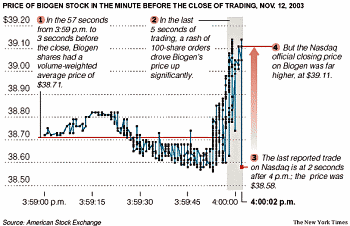|
How do you set the closing price of a stock? You'd think it would be
simple: the last trade of the day. But in a
decentralized
electronic market like NASDAQ there's no single auction, no single
price. Today's NYT has a clear
article explaining the problems that arise. The S&P 500 is
experimenting with switching away from NASDAQ to the
American Stock Exchange to set
closing prices. AMEX is a traditional
centralized human-mediated market; a single
specialist making book means you have a single price.
The fascinating story here is the manipulation of closing process by
"spraying":
a series of minimally sized
orders, e.g., 100 shares, immediately prior to the open or close that,
based on the amount of displayed size, outstrips
short-term liquidity and creates excessive price movement on a
temporary basis
By jamming in a bunch of orders at the last second you can
force a price swing. Why would you do that? Because a lot of
compound securities are pegged to the closing price of individual
stocks on NASDAQ. Crazy!
According to NASDAQ Head Trader Alert #2003-093 they have some quantitative process to detect spraying; when they find it, they take an average price from the last 15-30 seconds. Another interesting nugget is AMEX's memo to the SEC in November 2003. It's in response to NASDAQ trying to block the S&P change, basically explaining that this is a good change and AMEX has no say in it anyway. The real problem is the notion of a 'closing price' at all. Why not trade 24 hours a day? It will happen soon enough. The world gets faster. |
||

